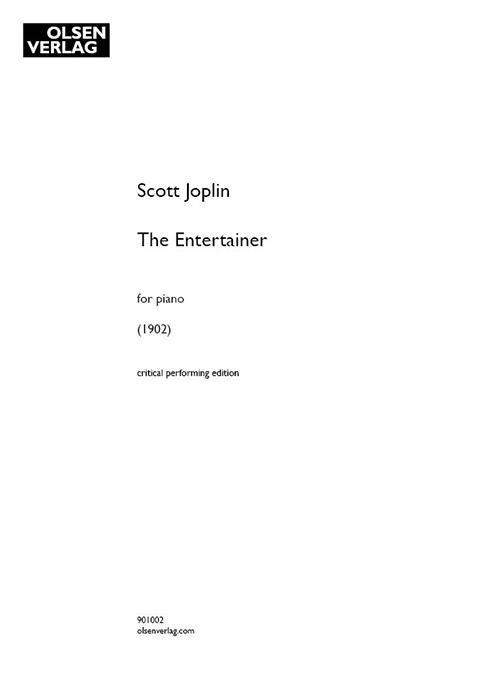Scott Joplin’s The Entertainer shot to fame after its use in the soundtrack to the film The Sting in 1973, and is still one of Joplin's best-loved works. Our new critical performing edition, edited by James Olsen and Elliott Park, is underpinned by the highest standards of musicological scholarship, and presents the musical text in clear, crisp print. It is accompanied by an historical note, an explanation of the sources used to produce the edition, and a detailed critical commentary. Printed on high-quality paper, it is robust enough to endure years of use.
You can read more about the editorial principles underlying our production of critical performing editions here.
After the success of Maple Leaf Rag and other classics, Scott Joplin (c.1868–1917) earned the title ‘king of ragtime’ (Berlin 2013a). Joplin had already achieved great fame and financial success for his rags, but The Entertainer raised his status when it was published in 1902. His music gained further recognition after its revival in the 1970s, and it was ‘anachronistically positioned alongside rock hits on the sales charts’ (Berlin 2013b). Moreover, the appearance of The Entertainer in the soundtrack to the film The Sting in 1973 caused the song to become ‘one of the most frequently played and recorded pieces of the 1970s’ (Berlin 2013b). Joplin’s output was not restricted to this genre, also including works such as marches, songs and two operas, but it is above all for ragtime that we remember him today.
Although ‘any music could be “ragged”’ (Middleton and Manuel 2001), there is a difference between sophisticated instrumental rags and folk-like ragtime songs. The first group, to which The Entertainer belongs, was ‘less popular with the public than the simpler, more accessible rags’ of other popular artists (Berlin 2013b). Despite writing within this first category, Joplin’s ragtimes had been regarded as popular music, influenced by traditional jazz and ‘honky-tonk’ styles (Berlin 2013a).
The revival of these works in the 1970s, prompted in part by classical pianist Joshua Rifkin’s 1970 recording Scott Joplin: Piano Rags, emphasised the classical nature and high-art status of Joplin’s compositions, and other classical musicians began to perform them, including orchestras and ensembles. Addison W. Reed, for example, claimed in 1975 that Joplin had ‘finally found his place in the sun and been accorded his rightful position as one of the first truly American composers’ (Reed 1975: 45). Other commentators have noted that Joplin ‘strove for a “classical” excellence in his music and recognition as a composer of artistic merit, rather than one simply of popular acclaim’ (2013a), and that his goal to create ‘distinctly American works that would be both popular and classic was realised’ (Wheeler 2020).
However, it is possible that these efforts to bring Joplin into the classical canon may have downplayed both Joplin’s ethnicity, and the significance of African American folk traditions in his music. More recent scholarship has emphasised these aspects, such as antiphony and the use of pentatonic scales (Stewart and Duran 2007: 97). The relationship between European classical and African American folk traditions in Joplin’s music is clearly a complex one, and is tied up with matters of race, class and power in American history. There can be no doubt, however, that Joplin is a hugely influential African American composer and figure in music history more generally. As Berlin notes, Joplin has ‘remained a presence in American life’ (Berlin 2013a).
The manuscript of this piece, like almost all of Joplin’s manuscripts, has not survived (Bolcom 1972: 147). The first edition of the piece was published in 1902 by John Stark & Sons (St. Louis) and dedicated to ‘James Brown and his Mandolin Club’. A copy is held at the Library of Congress (M31.J case). Joplin had a personal relationship with Stark’s publishing company (Berlin 2013a) and, according to William Bolcom, ‘did not benefit or suffer from much editorial supervision’ (1972: 149). Consequently, Bolcom argues, ‘we can be fairly sure that, in the main—except for mistakes—Joplin’s music was printed more or less as he wrote it’. No existing scholarship has cast doubt on the reliability of the 1902 source. For these reasons, we have based our edition on the 1902 edition.
References
Berlin, Edward. A. 2013a. ‘Joplin, Scott’, in Grove Music Online <https://doi.org/10.1093/gmo/9781561592630.article.A2253061>.
—— 2013b. ‘Ragtime’, in Grove Music Online <https://doi.org/10.1093/gmo/9781561592630.article.A2252241>.
Bolcom, William. 1972. ‘Ragtime Revival: The Collected Works of Scott Joplin’, Anuario Interamericano de Investigacion Musical, 8, 147–61.
Middleton, Richard and Peter Manuel. 2001. ‘Popular music’, in Grove Music Online <https://doi.org/10.1093/gmo/9781561592630.article.43179>.
Reed, Addison W. 1975. ‘Scott Joplin, Pioneer’, The Black Perspective in Music, 3(1), 45–52. https://doi.org/10.2307/1214379
Stewart, Earl, and Jane Duran. 2007. ‘Scott Joplin and the Quest for Identity’, Journal of Aesthetic Education, 41(2), 94–9.
Wheeler, Brad. 2020. ‘Scott Joplin is Granted Copyright for Maple Leaf Rag; Moment in Time Sept. 18, 1899’, Globe & Mail [Toronto, Canada], 18 September 2020, A2.

